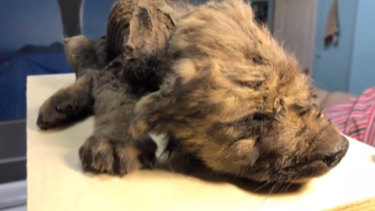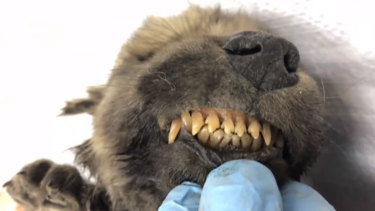Washington: An 18,000 world puppy unearthed in Siberia could prove to be the missing link between dogs and wolves, scientists believe.
The puppy was discovered perfectly preserved by permafrost near Yakutsk, in eastern Siberia, last northern summer and carbon dating has revealed it had been frozen for around 18,000 years.
The body of a perfectly preserved 18,000-year-old pup nicknamed Dogor has been found in the ice of the Siberian permafrost. Credit:Centre for Palaeogenetics/Twitter
Researchers at the Centre for Palaeogenetics in Stockholm, Sweden, announced this week that extensive DNA tests have so far been unable to confirm whether the animal was a dog or a wolf.
The experts believe this may be because the canine comes from the period when dogs were being domesticated, and hope the creature will prove crucial to uncovering when exactly the evolution began.
"It's normally relatively easy to tell the difference between the two," researcher David Stanton told CNN. "We have a lot of data from it already, and with that amount of data you'd expect to tell if it was one or the other.
"The fact that we can't might suggest that it's from a population that was ancestral to both – to dogs and wolves".
The dog, which could be the oldest ever confirmed, was found in 2018 . Researchers have not yet been able to tell if he was a wolf or a dog.Credit:Centre for Palaeogenetics/Twitter
A 2017 study published in the journal Nature Communications suggested that modern dogs were domesticated from a single wolf population 20,000 to 40,000 years ago, but tests on this specimen could offer further clues as to the precise period.
"We don't know exactly when dogs were domesticated, but it may have been from about that time. We are interested in whether it is in fact a dog or a wolf, or perhaps it's something halfway between the two," Stanton added.
"It seems that dogs were domesticated from a lineage of wolves that went extinct," he said. "So that's why it's such a difficult problem to work on to understand where and when dogs were domesticated."
The researchers' genome analysis has revealed that the puppy was a male so the scientists, after discussing with their Russian colleagues, have named the puppy "Dogor". The name means "friend" in Yakutian – as well as being a pun on "dog or wolf".
The scientists hope that further genome data tests on the creature will reveal more about Dogor's origins. Photographs released by the Centre for Palaeogenetics show the puppy in an almost perfect condition, with its nose, whiskers and teeth remarkably intact. Dogor can be seen almost completely covered in fur except for an exposed rib cage.
Dogor was discovered in a remote part of Siberia and is so well preserved because it was found in a tunnel that was dug into the permafrost.
The remains were later sent to Oxford University's Radiocarbon Accelerator Unit for dating
This revealed that the corpse dated back at least 18,000 years, meaning Dogor would have lived during the last Ice Age.
The carcass is being kept in Russia while Mr Stanton and his colleague Love Dalén study its rib bone back in Sweden.
Telegraph, London
Source: Read Full Article


